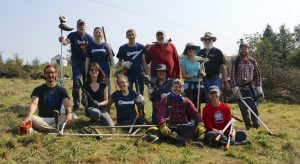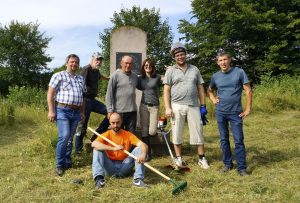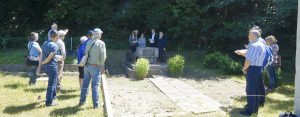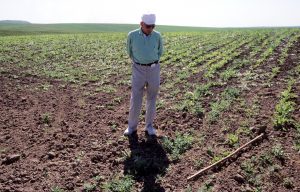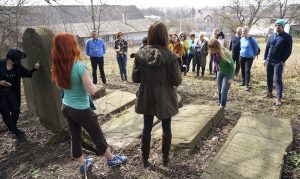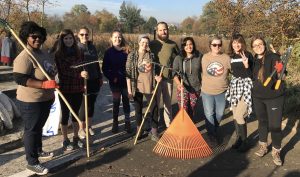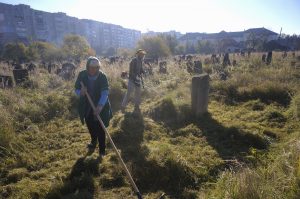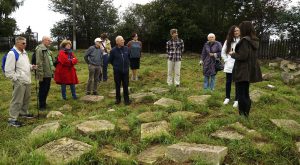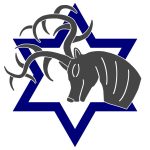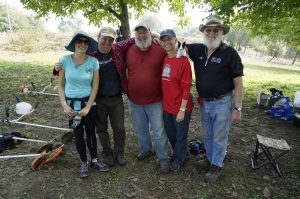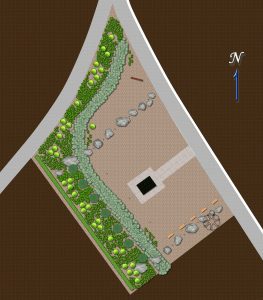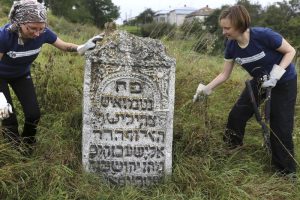This is a descriptive annual report for Rohatyn Jewish Heritage (RJH), for the calendar year 2018 – in essence a year-in-review summary of our project progress and events, with an outline of our finances as well. To compare our progress in 2018 to our forecast of a year ago, see also our report for 2017. This review is heavily hyperlinked to pages with more details and images, on or off of our website.
![]() Ця стаття також доступна українською.
Ця стаття також доступна українською.
PARTNERSHIPS
By far the most important theme in our work has been partnerships, clearly the essential element in our successes this year and in building foundations for future projects. Most of our partnerships are informal, connected by the volunteer efforts and spirit of the good people we keep meeting, from western Ukraine and from all over the world. All of the partnerships listed here have already been active for two or more years, but in some cases brought many new faces to us in 2018, to our continuing astonishment. Here very briefly are several groups who were active with us this year (you see them mentioned throughout our project updates below), with whom we hope to continue on their projects and ours for years to come: The Matzevah Foundation (TMF); the Lviv Volunteer Center (LVC); the Sholem Aleichem Jewish Cultural Center; Peace Corps Volunteers (PCVs) in Ukraine; Law Craft; the City of Rohatyn and the Rohatyn Opillya Museum; Rohatyn District Research Group (RDRG); Gesher Galicia (with whom we also continue to share efforts on historical maps and heritage concerns); the Center for Urban History of East Central Europe; and outside of organizations, we especially want to acknowledge our translators, our frequent heritage travel companions and friends (journalists, bloggers, and photographers), the many Fulbright scholars and students who met with us to exchange experiences and ideas, the dozens of people who reached out to us on Facebook to help with communication and information, and the many friends and citizens of modern Rohatyn who help keep us connected to news and events in town.
PROJECTS
The News section of our website captures much of our project progress this year, but here is a quick summary of the major events. With the help of dozens of friends and colleagues in several volunteer organizations (TMF, LVC, and many Peace Corps Volunteers), and dozens of kind people who donated to fund purchases of hand and gas-powered landscaping tools and supplies, this year we were able to clear wild vegetation from nearly the entire old Jewish cemetery in Rohatyn, as well as half the new Jewish cemetery, and a portion of the south mass grave site around the 1998 memorial.
We began the year by interviewing a Rohatyn man who was an eyewitness to previously undocumented mass grave areas at the north site, marked the 76th anniversary of Rohatyn’s first wartime aktion in March, joined friends to mark the 75th anniversary of the Rohatyn ghetto liquidation in June, and ended the year in the early planning stages of landscape designs for the south mass grave site (see our 2019 plans below). Headstone recovery work was very light this year, with only a single stone recovered, from vul. Drahomanova; Mr. Vorobets has been in ill health for much of this past year, and toward the end of the year he returned to us the small cash fund he was holding to pay occasional in-town workers. However, city utilities projects and other construction work will continue in coming years, so we anticipate many more stones will surface over time.

A collage of images from our week working together in Rohatyn’s old Jewish cemetery.
Photos © 2018 TMF and RJH.
In 2018 we kicked off an effort to get the four Jewish burial sites in Rohatyn (cemeteries and wartime mass graves) registered as regional and national heritage sites; that effort is led by our attorneys, who are working with officials at all levels of government in Ukraine to establish rules and methods, while we supply data, in what we expect will be a long-term effort. Also this year we helped publish the wartime memoir of Jack Glotzer, working with Jack’s children to make the text freely accessible; it is available in an English-language pdf and as hypertext with images on our website, plus a translation to Polish was generously provided by Robert Gruszczyński, and a translation to Ukrainian was kindly funded by friends who lead the Bolechow Jewish Heritage Society. We also both contributed articles to a special edition of Gesher Galicia‘s quarterly research journal The Galitzianer, which focused entirely on the Jewish history and heritage of Rohatyn; Gesher Galicia generously gave us permission to make this journal issue available for free access on our website.
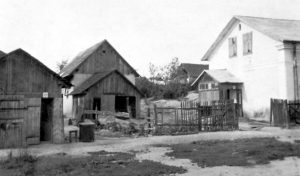
A location in the Rohatyn ghetto where a large Jewish bunker was built. Source: IPN.
At this stage of our NGO’s development, the RJH website continues to be our primary resource for documenting the history of Rohatyn’s Jewish community and our heritage project work in the town. This year we significantly extended the section on history, including a timeline of the Shoah in Rohatyn (completing our timeline series) and focus articles on righteous gentiles in and near Rohatyn under German occupation, the wartime Katzmann report to Nazi authorities, Rohatyn letters and reports in the Ringelblum archive, and Rohatyn in the USHMM encyclopedia of camps and ghettos. In addition to publishing Jack Glotzer’s wartime memoir, we also summarized and reviewed other memoirs of pre-war and wartime Jewish life in Rohatyn, by Rosette Faust Halpern, Sylvia Lederman, Paul Trepman, and Alexander Kimel, as well as a summary of the Rohatyn Yizkor book and the Pinkas hakehillot Polin chapter on Rohatyn, plus Rohatyn-related post-war video interviews conducted by the USC Shoah Foundation. These history documents and personal memoirs continue to serve our heritage, history, and education work. As always, we aim for 100% dual-language (English and Ukrainian) content on our website, and this year again our over-worked translators have supported us reliably and with great care and sensitivity; they are a treasure we could not function without. See the operations costs associated with translation in the financial summary below.
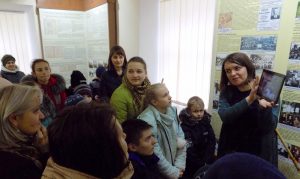
Visitors in the Jewish history section of the new museum. Source: Bohdan Danyliak via Rohatyn Opillya Museum.
The education component of our work got a huge boost late this year when the City of Rohatyn’s new regional history museum “Opillya” opened, after two years of development, including contributions we made to descriptive panels on the chronology and culture of the now-lost Jewish community. Objects donated by us and by several other Rohatyn Jewish descendants are labeled and displayed in cases in a room which illustrates the multicultural past of the area, and the 1930s film on Rohatyn by Fanny Holtzmann plays in continuous loop on a computer panel there as well, thanks to research and donations by other Rohatyn Jewish descendants. The museum is now an obvious starting point for visitors to Rohatyn, and a research reference for us and others working to illuminate the area’s past for benefit of the present.
Elsewhere in the education sphere we again participated in a Centropa Trans.History conference in Lviv for educators working to include Jewish history and perspectives in their materials at high school and university courses, and this year we led a tour of Rohatyn’s Jewish heritage sites for about 25 of the participants. We continued to give interviews and appear in news coverage by journalists for a wide variety of publications, including local Ukrainian and Jewish press, a diaspora Ukrainian internet radio program, Jewish press in North America, the Associated Press text and video services, a Swedish-language culture and social blog based in Lviv, and the Memoria journal of the Auschwitz-Birkenau Memorial and Museum; you can find most of those pieces linked to our Media page. At the end of the year, Marla was invited to share a panel in London on heritage and memory in post-Holocaust Ukraine, giving us an opportunity to speak about our efforts with an interested audience we rarely get to reach in person. A major event for us this year was our participation with the City of Lviv and colleagues in key NGOs plus charitable and academic institutions in the city in nominating and celebrating recipients of “A Key to the City” for their support of Jewish culture and communities in western Ukraine or their work on projects of memory recovery and heritage preservation in the region; we were especially proud to be one of the recipients ourselves.
Our project work was not only focused on Rohatyn, as our close relationships with regional heritage activists give us many opportunities to support their work as they support ours. For two days in July, we joined the well-organized international volunteer work camp led by the Lviv Volunteer Center (LVC) to clear vegetation and repair monuments at Jewish cemeteries and mass grave sites around Drohobych and Boryslav in the Lviv oblast. In October, we spent a day clearing vegetation and trash from a large portion of the Jewish cemetery in Kalush in the Ivano-Frankivsk oblast, as part of a large project organized by the Peace Corps Volunteer working in the city. To both of these projects, we brought hand and power tools purchased this year for use clearing the Rohatyn heritage sites, amplifying the efforts of the volunteers.
Closer to home, in late June we also worked for five days under the leadership of the LVC and the Sholem Aleichem Jewish Community Center in an emergency rescue of more than a hundred Jewish headstones from under a street in the city; the stones had been stolen from the new Jewish cemetery in Lviv during the German occupation and used as foundation materials for the street. In addition to our labor in the street, Marla also posted extensively about this action, crowd-sourcing volunteers, public interest, and donations for equipment rental and a future memorial at the cemetery. In November we participated in a conference on the Holocaust in Ukraine organized by one of our Peace Corps Volunteer friends at a gymnasium in Yavoriv (north of Lviv), where Marla presented our project in Rohatyn to students, teachers, and city officials. Although we haven’t reported on our website about all of the events mentioned above, several articles were written by others about the work, some of which are linked to our Media page.

Images from the headstone rescue project on vul. Barvinok in Lviv, led by the LVC. Photos © 2018 RJH.
VISITORS
As we did in 2017, in 2018 we made numerous trips from Lviv to Rohatyn, for project work, meetings, commemoration and city events, and to guide visitors from abroad around the Jewish heritage sites. Overall we made 19 round trips to Rohatyn, spending 24 days and 5 nights in the city, often with other working volunteers and with tools. Several of our trips included visits to towns and villages in the region around Rohatyn, to research forest and bunker locations described in personal memoirs of Jewish survivors of the Rohatyn ghetto, and the village depicted in Fanny Holtzmann’s 1930s home movie. In addition to the Centropa conference participants described above, we also led a large tour group from Ohev Sholom Synagogue in Washington DC, and a large Swedish group organized by our friends at Lviv Resor. We are pleased as well that many visitors are able to tour the heritage sites on their own now, using the resources on our website and occasional tips from us through messages and map links; in April, those resources helped a group of almost 20 descendants and friends of one of the Stratyner rabbi families of Rohatyn pay their respects at the old Jewish cemetery and other sites, and in May our friend Christian Herrmann led a large German group through Rohatyn as part of an extended tour of Jewish heritage sites in western Ukraine and Moldova.
ADMINISTRATION
Rohatyn Jewish Heritage continues as a registered Ukrainian non-profit NGO with two employees (Marla and me) and three board members; the board includes our long-time friend and advisor Wito Nadaszkiewicz, executive director and managing partner of LawCraft Legal Services and Consulting in Lviv. In addition to managing the NGO’s registration, accounting, and regulatory compliance, Wito and his staff also interact with contractors and suppliers on our behalf, managing a significant portion of the “business” side of Rohatyn Jewish Heritage while we focus on projects and communication. This arrangement has been quite productive for us over the past two years, and we expect to continue in this mode for the foreseeable future. We credit Wito’s long-range vision for helping us chart a project path, and are deeply grateful that much of LawCraft’s work for us is provided pro bono, to permit donations we receive and our personal resources to be applied directly to project work.
This year we finally created a logo for Rohatyn Jewish Heritage, and quickly applied it to T-shirts which we could give to volunteers supporting us in cemetery clearing and other important projects. It has been fun to see our logo appearing on people in Ukraine and abroad.
FINANCE
As in 2017, we continue to maintain dual-track personal (US) and NGO (UA) bank accounts to stay flexible and reliable in receiving donations and covering project expenses. As always, we record and acknowledge all donations, and every donation (less banking and transfer fees) goes directly to project expenses. Marla and I contribute additional money from our personal savings to cover all administrative and operational costs, including our own salaries, plus some incidental project expenses. For the calendar year 2018, in US$ and using a nominal exchange rate of US$1=25UAH to allow for currency exchange and transfer fees (through 2018 the rate ranged 25.7UAH to 28.7UAH):
Old Cemetery Clearing Project 2018 (one-time): US+UA bank accounts
tools & accessories -$ 4,497 (71%)
lodging RJH+volunteers -$ 695 (11%)
services: fuel, transport, etc -$ 718 (11%)
meals, water RJH+volunteers -$ 413 ( 7%)
---------------------------------------
total project cost 2018: -$ 6,323
individual donations via GG +$ 5,024
donation from TMF +$ 900
donations from other sources +$ 399
---------------------------------------
end balance: $ 0 (project is closed, but the
remaining tools and supplies inventory is held by RJH for use in 2019)
[approx. breakdown of tool costs:
66% (US$2990) motor tools & accessories
20% (US$ 877) hand tools & accessories
8% (US$ 339) safety & protection
6% (US$ 291) other supplies (tarps, etc.)]
NGO projects & operations (ongoing): US+UA bank accounts
(not including 2018 old cemetery project)
start balance: +$ 9,514
---------------------------------------
headstone recovery labor -$ 9
headstone recovery refund +$ 187
ground transport Lviv/Rohatyn -$ 1,192
translations EN->UA -$ 1,201
transcriptions UA -$ 230
printing+binding -$ 218
website domain, hosting, apps -$ 223
volunteer meals @ worksites -$ 15
volunteer perks: T-shirts etc -$ 755
wire transfer fees -$ 27
---------------------------------------
net change 2018: -$ 3,683
individual donations via GG +$ 8,316
Osborn personal contribution: +$ 1,056
---------------------------------------
end balance: +$15,203
[balance = +$8303 US, +$6900 UA]
NGO administration, salaries, etc.: UA bank account
start balance: +$ 362
---------------------------------------
permit and gov't fees -$ 1,179
accounting fees -$ 960
salaries+benefits+taxes -$ 4,758
---------------------------------------
net change 2018: -$ 6,897
Osborn personal contribution +$ 6,800
---------------------------------------
end balance: +$ 265
This summary may require updating after the first of the year to include late-year donations or expenses, and a final reckoning by our accountant. Note that this year we merged headstone recovery project accounting with general NGO projects+operations accounting, consistent with the original program intent.
Absent from this summary is the significant volunteer time donated by many friends and organizations to make many of these projects and our operations possible; we count that as a debt we hope to pay back by helping others. Also absent are expenses carried by the volunteers; in addition to making a large cash donation (noted above) to the old cemetery project this year, The Matzevah Foundation also carried all of their own expenses for lodging, meals, and transportation during the five days of site work, as well as their transport costs from Poland or America to Lviv. Throughout, the list also omits personal pass-thru and side donations (e.g. artifacts for the Rohatyn Opillya Museum, books for the Rohatyn public library, etc.) made by others and by Marla and me, and ignores many small expenses which we and others chose to pay out of our pockets, for simplicity. And of course Marla and I do not count our own volunteer effort, working full-time for our NGO.
We want to thank Gesher Galicia, and in particular their membership chair Shelley Kellerman Pollero and CFO/treasurer Ann Gleich Harris, for making the donations process to Rohatyn Jewish Heritage tax-deductible for US taxpayers, and simple for everyone.
LOOKING TO 2019
After eight years of experience and two years of full-time work, we now have momentum and can better plan and manage small and medium-sized projects. In 2019, we hope to start and complete a major rehabilitation of the south mass grave site, to improve protection of the grounds, to enhance the appearance and signage, and to reduce the need for ongoing landscape maintenance. Depending on funding sources and our experience with the south mass grave project, we may also begin planning for rehabilitation of the old Jewish cemetery.
Also in 2019, we aim to produce a locally-printed version of Jack Glotzer’s memoir in book form, at least in Ukrainian but hopefully in a bilingual format (including English). This project is already funded but needs research into local publishing houses and new formatting of the texts. As agreed with Jack’s children and the donors, the book will published non-commercially, and made available for free to libraries, schools, and other institutions in the region.
Through collaboration with Gesher Galicia, 2019 should also see online publication an interactive historical map of Rohatyn which features family history data at least to World War I pinned to locations in the town. Although the primary research for this effort indexed Jewish records, historical property documents and some other records include data for nearly every family in the town.
Many of our past efforts will continue in similar trends, including landscape maintenance at the Rohatyn burial sites (with friends and colleagues as usual), and we intend to again return the favor by helping these friends with tools and labor on their own projects. We still have sections of the website which we want to develop further from our research, including the sections on history and memoirs, maps and geography; we also plan to simplify the project section and separately highlight the heritage in Rohatyn and the region as a section of its own, to better support visitors who wish to see and understand the sites. We hope to collaborate with the Rohatyn Opillya Museum to create informative digital and/or brochure-format walking/driving tours focused on the Jewish history and heritage in the area.
THANK YOU TO OUR SUPPORTERS
As should be apparent by the end of this report, Rohatyn Jewish Heritage thrives on the support of interested and engaged friends near and far. Let us say again what we said last year: Marla and I want to thank everyone who led, supported, encouraged, funded, reported, corrected, translated, and shared our work in 2018, which enabled and amplified our efforts well beyond anything we could have done ourselves. We are grateful for the time, ideas, connections, donations, labor, humor, and love we received in this work, which has been inspiring again and again. Needless to say, we are looking forward to 2019, and if we may offer this wish to everyone: Next year in Rohatyn!

